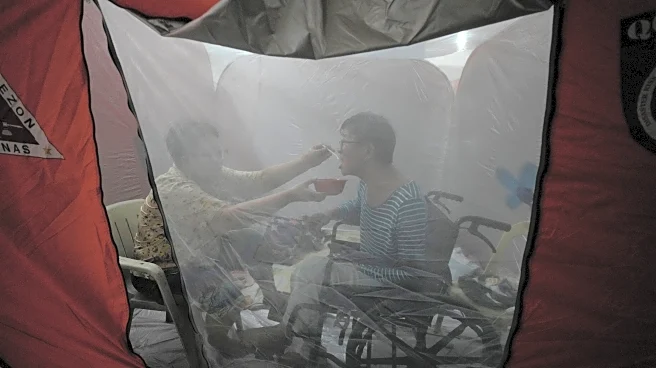What's Happening?
Super Typhoon Fung-wong has struck the Philippines, bringing winds of up to 185 kilometers per hour and gusts reaching 230 kph. The storm, considered the most powerful to threaten the country this year,
has led to the evacuation of over a million residents. Among those affected are Judy Bertuso and her husband Apollo, who have taken refuge in a temporary shelter set up in a basketball court in Quezon City. The couple left their creekside home due to fears of flooding, a concern heightened by previous inundations during heavy rains in October. The evacuation centers, filled with families in bright tents, are witnessing a mix of quiet conversations and children's play, as people seek safety from the storm's impact.
Why It's Important?
The evacuation of over a million people highlights the severe impact of Typhoon Fung-wong on the Philippines, a country frequently affected by such natural disasters. The storm's intensity underscores the vulnerability of the region to extreme weather events, which can lead to significant human and economic costs. The displacement of families and the need for emergency shelters reflect the ongoing challenges in disaster preparedness and response. This situation may prompt further discussions on improving infrastructure and community resilience to better withstand future storms, potentially influencing policy decisions and international aid efforts.
What's Next?
As the storm continues to affect the region, authorities are likely to focus on providing immediate relief and support to the displaced populations. Efforts will be made to assess the damage and begin recovery operations once the storm subsides. The government may also review and enhance its disaster preparedness strategies to mitigate the impact of future typhoons. International aid and support could be mobilized to assist in the recovery process, while local communities work towards rebuilding and restoring normalcy.
Beyond the Headlines
The recurring nature of typhoons in the Philippines raises questions about long-term climate resilience and adaptation strategies. The impact of such storms on vulnerable populations highlights the need for sustainable development practices that prioritize environmental and social considerations. The cultural dimension of community support and resilience, as seen in the interactions within evacuation centers, reflects the strength and solidarity among affected individuals, offering insights into the human capacity to endure and adapt in the face of adversity.












